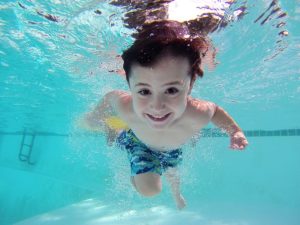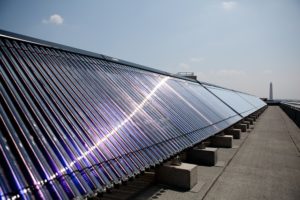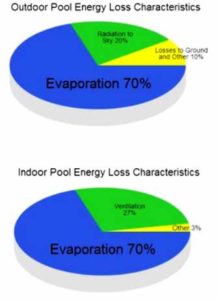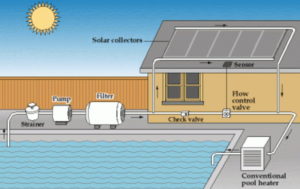Danny Sammber
Contents
Solar Pool Heating
When designing a swimming pool of any type, it is necessary to plan the water heating system in advance. At the same temperature, cooling in water occurs about 20 times faster than in air. Therefore, in standard and large swimming pools with a track length of 80-160 feet, a water temperature of about 72F is sufficient, and in the educational swimming pools with a 25-50 feet track length the water temperature should be 73-79F.
 Water temperature in the pool for medical purposes should exceed 79-80F, and it is best to be within 82F. Individual indoor pools it is recommended to maintain the water temperature at the level of 75-82f, and for young children 82-86F.
Water temperature in the pool for medical purposes should exceed 79-80F, and it is best to be within 82F. Individual indoor pools it is recommended to maintain the water temperature at the level of 75-82f, and for young children 82-86F.
Indoor micro-pools should have the following microclimate parameters: water temperature 82 ~ 86F; the air temperature is 3-5F higher than the water temperature, because evaporation of moisture from wet human body after bath removes heat.
People activity in open-air swimming pools is usually higher than in closed ones. Therefore, the air temperature in open ones is usually lower (70-77F), in the presence of solar radiation. It is necessary to consider a beneficial effect of fresh air, which retains a sense of comfort even at lower temperatures and high speeds of outdoor air movement. In order to create comfort and improve the microclimate, especially with a long bathing season it is recommended to heat the pool water.
 For a long time, open pools were heated from the house heating system using a flow heat exchanger. However, in recent years there have been many new options for heating pools: heating with boiler, direct-flow fuel heaters, direct-flow electric heaters, heat pumps, heating with solar collectors.
For a long time, open pools were heated from the house heating system using a flow heat exchanger. However, in recent years there have been many new options for heating pools: heating with boiler, direct-flow fuel heaters, direct-flow electric heaters, heat pumps, heating with solar collectors.
For owners of swimming pools, both open and closed types, it is very beneficial to use solar energy to heat and maintain a comfortable water temperature. Advantages of this method even more, if the system is connected with the solar heating system of the whole house, since it allows the use of excess heat and ultimately shortens the payback period of the solar system.
In addition, the presence of the pool avoids overheating of the coolant in the solar circuit in the summer. The only requirement for efficient operation of the solar system is the need to place the pool in a plays, which is in the sun’s rays for four to five hours a day. In this case, you can raise the water temperature much above the ambient temperature.
Solar radiation can completely replace the traditional energy source in summer and extend the swimming season in outdoor swimming pools for 1.5-2 months per year.
How it works
Any solar pool heating system consists of three main elements: a solar collector, pump with a filter, and control valve. The mechanism is very simple. Colder water from the pool is sent through a filter into the heat exchanger of the solar system. The filter is used to prevent debris from entering the solar collectors. In some cases, you may need an additional pump or a slightly more powerful pump for the filtration system.
The most effective modern systems include an automatic tap valve. The pool heating system is set to work during the most intense sunlight. During this time, if the sensor determine that a sufficient amount of heat is being supplied to the solar collector, system gives to the automatic tap-off valve a command to direct the flow of water from the pool through the heat exchanger of the solar collector. If the solar collector is cool, the water does not run through it.
The solar collector is most often located on the roof, however, it is necessary to observe the basic design standards. It must have a slight slope (not more than 30 degrees), the return pipeline should be located higher than the water supply pipes, and all the hoses should gradually rise so that during operation they expel all air. On pitched roofs, it should not deviate from the direction to the south by more than 45 °, but roofs with slopes directed to the east or west are also suitable for installation, but in such cases should have enlarged area.
The maintenance of pool heating solar systems is rather simple. In fact, all you need is to clean filters and prepare the system for the winter season: drain the water from the system if it does not drain automatically. Solar systems with antifreeze coolant does not need seasonal maintenance, since the coolant is resistant to low temperatures. Equipment for solar pool heating works at least 20 years, with a warranty period of 5-10 years.
How to Reduce Heat Loss
Before choosing a heating system, it is recommended to determine the costs associated with it. To to calculate heater parameters you need to know the average heat loss of the pool.
 The pool loses its warmth when cause
The pool loses its warmth when cause
- evaporation of water
- natural convection and radiation
- losses through the edges and splashing when people leave the pool
- thermal conductivity from the bottom to the ground
Heat losses are also determined by the habits of the users.
In open pools without heating the water temperature rises or remains constant during the day, and significantly decreases at night. A pool cover helps significantly reduce temperature drop, covering reduces losses in the open pools up to 80% (with thermal insulation). Water should be removed from the surface of the cover. Accumulation of rainwater on the cover surface contributes to heat losses during evaporation. The cover in the form of a solar collector can remain above the pool and in the daytime when the pool is not used. Such a cover from the translucent heat-insulating top layer and the absorbent layer adjacent to the water significantly improves the absorption of sunlight. As the researches shows, under favorable weather conditions, using shelters in the form of a solar collector allows you to operate a pool with a water temperature of 23 ° C without additional heating.
Indoor swimming pools have three significant differences compared to outdoor swimming pools:
- They are used mainly in the winter period, when the intensity of solar radiation is small
- The temperature level in them is much higher
- There is often even a need for air conditioning (at least in public swimming pools).
When all necessary technologies are implemented, the energy consumption decreases up to 60% of the initial value. At the same time, the required area of the solar collector decreases proportionally.
Efficiency of Solar Pool Heating System
You can determine the efficiency of a the solar heater by the collector’s thermal performance rating. The rating is measured by Btu per day per square foot: Btu/(ft2day). Another way is measuring by megajoules (MJ) per day per square meter: MJ/(M2day)
It can also be measured by Btu per day, which is simply the rating in Btu/(ft2day) multiplied by the area in ft2. Also used is MJ per day, which is the rating in MJ/(M2day) multiplied by the area in M2.
The higher the number, the greater the solar energy collection efficiency. However, because weather conditions, instrumentation accuracies, and other test condition constraints can vary, the thermal performance of any two collectors should be considered approximately the same if their ratings are within 25 Btu/(ft2day) of each other.
High efficiency solar collectors not only will reduce your annual operating costs, but may also require fewer square feet of collector area to heat the pool.
A pool that is properly heated and properly used can contribute to and help safeguard health. Doctors and physical therapists regard swimming as one of the most beneficial of cardiovascular exercises. It is an exercise that nearly everyone can do safely, while running and jogging are impossible for many elderly people and those who suffer from arthritis and muscular diseases.
By heating your pool, you make it possible to engage more often in swimming exercise because you extend the hours and the season your pool may be used.
A heated pool prevents chilling and the problems caused by the loss of too much body heat. Pediatricians say very young children are especially susceptible to various respiratory infections which may result from repeated chilling – and this is also true of elderly swimmers.
A heated pool is a must for therapeutic benefits and when swimming for relaxation. Doctors and Red Cross swimming experts recommend pool temperatures of from 78 degrees F for recreation and competitive sports swimming, to 90 degrees F or more for certain physical therapy patients.


Very informative